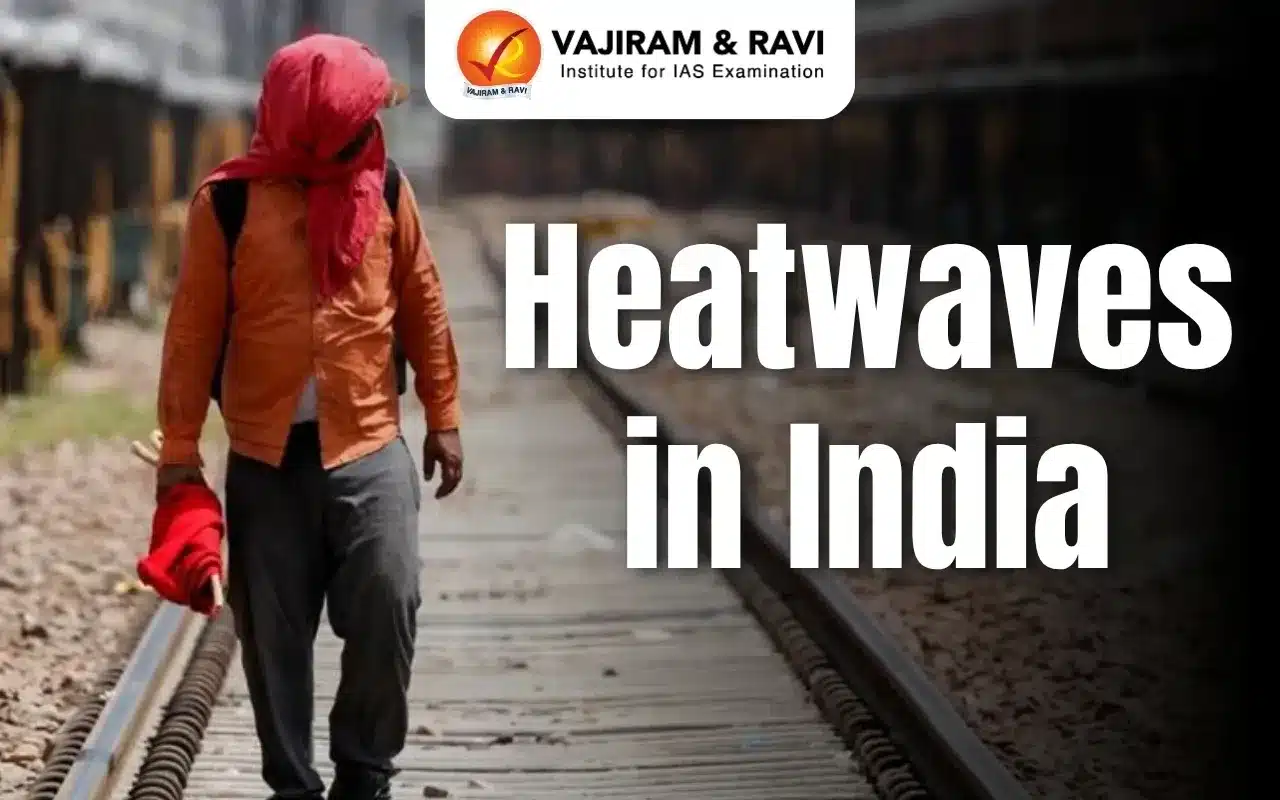Heatwaves in India Latest News
- India experienced an early and intense heatwave in 2025, with temperatures rising as early as late February. The early arrival of the monsoon brought some relief, but the economic and human toll of extreme heat remains severe.
- According to the International Labour Organization (ILO), over 70% of global workers face heat exposure risks, with India losing an estimated $100 billion due to heat-induced productivity losses. Informal workers—such as farmers, construction labourers, street vendors, and delivery personnel—are particularly vulnerable.
- Agriculture is significantly affected, as studies show that a 1°C rise in temperature can reduce wheat yields by 5.2%.
Worsening Heatwave Conditions in India
- Heatwaves—periods of abnormally high temperatures—typically strike India between March and June, peaking in May.
- Central, Northwest, East, and North Peninsular India are the most affected.
- A report by the Council on Energy, Environment and Water (CEEW) shows that 57% of Indian districts, home to 76% of the population, are at high or very high heat risk.
- States like Delhi, Maharashtra, Gujarat, Rajasthan, and Tamil Nadu are particularly vulnerable.
- Heat extremes have increased linearly from 1981 to 2022, with severe waves in 2013, 2016, 2019, 2022, and 2024.
Urban Heat Island Effect Intensifies Risk
- Urbanisation has worsened heatwave impacts. Cities absorb and retain more heat, making nights warmer—a phenomenon known as the urban heat island effect.
- This reduces relief during nights, especially in Tier-II and Tier-III cities, thereby affecting sleep and overall recovery from daytime heat.
Labour and Economic Impact
- India’s workforce is highly vulnerable to heat. A 2022 World Bank report states that 75% of the workforce (380 million people) is exposed to heat-intensive work.
- India could face 34 million job losses due to heat stress by 2030.
- Informal sector workers suffer the most, with net earnings in Delhi dropping by 40% during heatwaves.
- These workers are often unable to attend work, sleep poorly, and face increased illness in their households during extreme heat.
Productivity Loss Across Sectors
- Factory and blue-collar workers also experience reduced output.
- A 2021 study led by Dr. Somanathan found that each 1°C increase in temperature could reduce manufacturing output by 2%.
- Rising absenteeism and declining efficiency are common during hot days.
- Improving worker productivity could drive employers to invest in heat-protection measures.
Rural and Agricultural Vulnerability
- In rural India, summer is typically a lean farming season, but many shift to non-farm jobs like construction and road building, increasing their exposure.
- Livestock are also susceptible to heat stress, especially when temperature and humidity exceed certain thresholds.
- Enforcement of animal welfare guidelines remains weak among small and marginal farmers.
Compounding Effects of Climate Events
- Heatwaves worsen when combined with droughts or food shortages.
- Unseasonal high temperatures—like those in early March or late October—can damage crops and affect productivity even outside the peak heatwave season.
Government Measures to Tackle Heatwaves
- The Central and State governments are actively addressing heatwave challenges.
- The National Disaster Management Authority (NDMA), along with the Union Ministry of Home Affairs, has issued comprehensive guidelines to safeguard workers.
- These emphasize education, regulated work hours, access to water, medical aid, and suitable clothing, and serve as templates for city and town-level heatwave action plans.
Localized Heat Action Plans
- Many States and cities have adopted localized heat action plans, some extending down to the ward level.
- These plans incorporate:
- Short-term solutions: Water stations, shaded public shelters (e.g., cool bus stops).
- Long-term strategies: Urban greening and expanding water bodies.
- For instance, Chennai has mapped urban heat islands and integrated this data into its city master plan.
Urban Focus and Rural Neglect
- Most current heatwave preparedness focuses on urban areas due to their dense populations and infrastructure.
- However, experts warn that rural regions face serious risks due to:
Weak Healthcare Infrastructure
- Poor quality of housing
- Limited access to water, electricity, and sanitation
- This makes rural communities highly vulnerable to heat-related health issues.
Funding and Strategic Planning
- States can utilize the State Disaster Management Fund to address immediate needs during heatwaves.
- However, experts stress the importance of long-term investments and strategic planning, especially in cities, to build resilient infrastructure and execute comprehensive heat action plans.
Social Protection for Heat-Affected Workers
- To safeguard incomes, especially for informal workers, mechanisms like heat insurance are being explored.
- Under such models, workers contribute small premiums and receive compensation if a heatwave halts work.
- However, implementation challenges remain significant.
Heatwaves in India FAQs
Q1. What is a heatwave?
Ans. A heatwave is an extended period of unusually high temperatures, especially common from March to June in India.
Q2. Which regions are most affected by heatwaves in India?
Ans. Central, Northwest, East, and North Peninsular India are most vulnerable to recurring and intense heatwaves.
Q3. How do heatwaves affect Indian labour productivity?
Ans. They reduce productivity, increase absenteeism, and cause income losses—especially among informal and outdoor workers.
Q4. What sectors face the biggest heatwave losses?
Ans. Agriculture, construction, and manufacturing sectors suffer due to heat-related stress and reduced work hours.
Q5. What measures are being taken against heatwaves?
Ans. Governments implement Heat Action Plans, improve water access, and explore insurance and compensation mechanisms for workers.
Last updated on December, 2025
→ Check out the latest UPSC Syllabus 2026 here.
→ Join Vajiram & Ravi’s Interview Guidance Programme for expert help to crack your final UPSC stage.
→ UPSC Mains Result 2025 is now out.
→ UPSC Notification 2026 is scheduled to be released on January 14, 2026.
→ UPSC Calendar 2026 is released on 15th May, 2025.
→ The UPSC Vacancy 2025 were released 1129, out of which 979 were for UPSC CSE and remaining 150 are for UPSC IFoS.
→ UPSC Prelims 2026 will be conducted on 24th May, 2026 & UPSC Mains 2026 will be conducted on 21st August 2026.
→ The UPSC Selection Process is of 3 stages-Prelims, Mains and Interview.
→ UPSC Result 2024 is released with latest UPSC Marksheet 2024. Check Now!
→ UPSC Prelims Result 2025 is out now for the CSE held on 25 May 2025.
→ UPSC Toppers List 2024 is released now. Shakti Dubey is UPSC AIR 1 2024 Topper.
→ UPSC Prelims Question Paper 2025 and Unofficial Prelims Answer Key 2025 are available now.
→ UPSC Mains Question Paper 2025 is out for Essay, GS 1, 2, 3 & GS 4.
→ UPSC Mains Indian Language Question Paper 2025 is now out.
→ UPSC Mains Optional Question Paper 2025 is now out.
→ Also check Best IAS Coaching in Delhi
Tags: heatwaves in India mains articles upsc current affairs upsc mains current afffairs

















